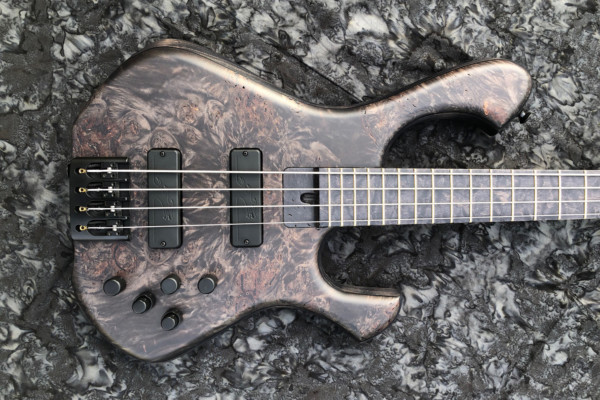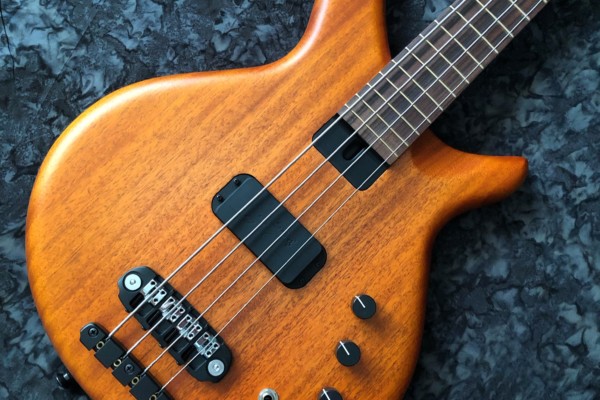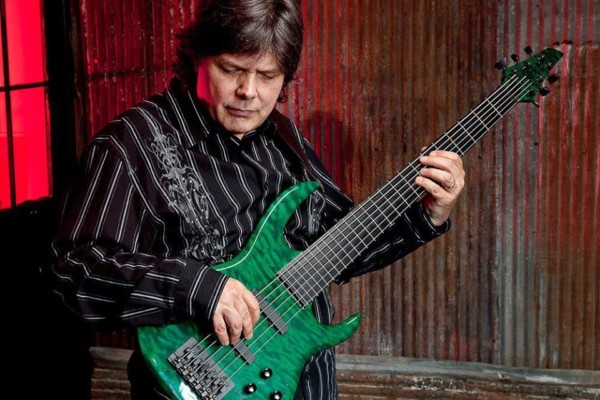Bass Artisan: An Interview with Pete Skjold
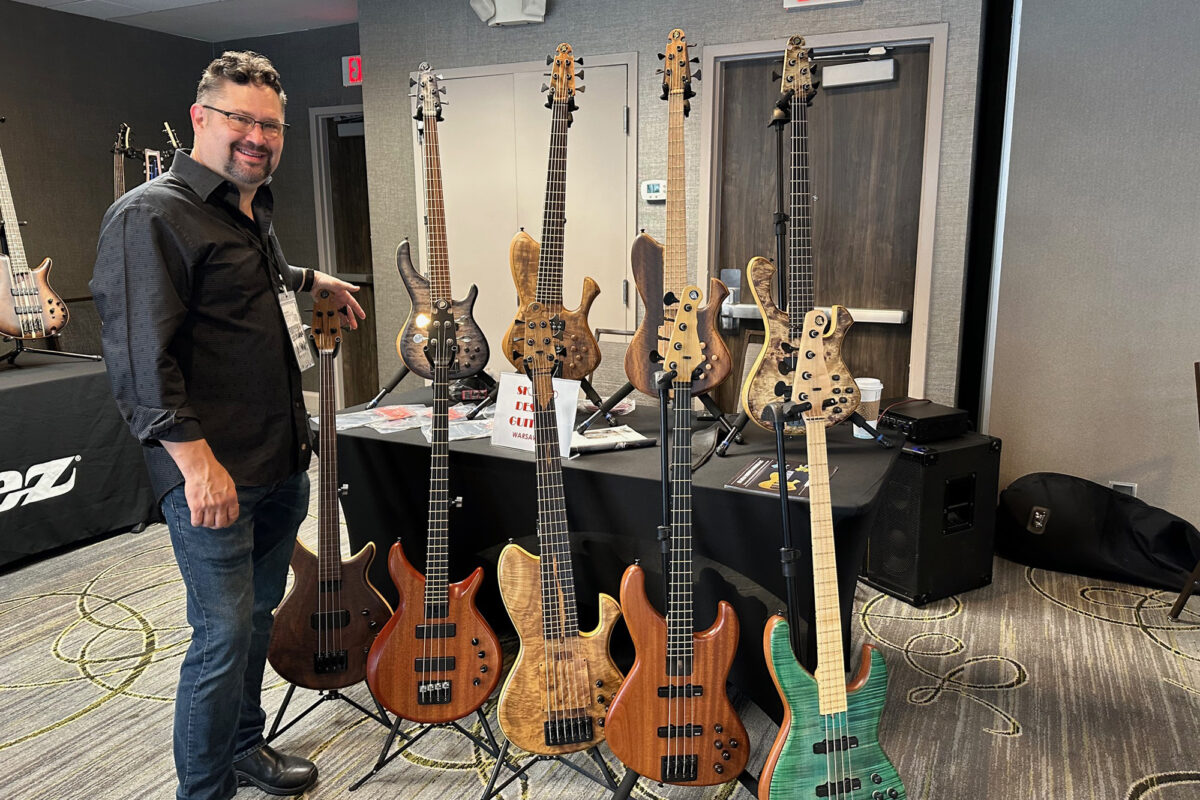
Big companies produce most of the bass guitars in the world, but independent luthiers have pushed the bass guitar’s evolution forward over the past 50 years. Craftspeople, driven by passion, have dedicated their lives to improving playability and tone that will inspire whosoever wields their instrument. They create pieces of art that, in turn, create pieces of art.
One of the undeniable forces in the bass-building world is Pete Skjold, who is the epitome of an artist. His borderline obsession with creating the perfect instrument has created a legacy for his brand, Skjold Design Guitars. 2023 marks the company’s 20th anniversary, proving he has the perfect mix of talent and perseverance to sustain in a difficult and niche market.
We caught up with Skjold to talk about his two decades in business, the realities of building for a living, his bass designs, and what’s coming next from SDG.
It’s been a while since we’ve caught up. I know Corey saw you at the Gear Expo at Gerald Veasley’s Bass Boot Camp.
Yeah. I go there more to see old friends and artists who work with me as much as I do at the expo, but it’s really a community thing. It’s been that way for a long time. I didn’t realize how long I’ve been doing it… I think they just celebrated 20 years last year. So it was pretty crazy.
I’ve been going there a long time, and I helped the expo get going before they had an actual expo. I kept showing up with my basses because David Dyson, Damian Erskine or another one of my artists was playing. [The Bass Boot Camp people] said, “You think you could get other guys to show up with their stuff, too?” I knew I could, so I made a few phone calls, and everyone was into it, so it became a hang for a lot of us.
I get to hang out with Michael Tobias and Dave Segal from New York Bassworks and just a bunch of other great luthiers we know. It’s been a lot of fun.
When I saw that you’re celebrating 20 years, I could have sworn it’s been 30. But it has been 31 years since you originally designed the Standard 92, correct?
Yeah, the 92 was the first instrument I designed, so I’ve been building since then. I started building in ’96, but I count the day I got my business license as the day it started, which was September 3rd, 2003. So for 20 years, it’s been basically my sole income.
It’s a crazy thought when you think about how long I’ve been doing this. It goes by really quickly, and it seems like yesterday I started, and it still seems like I’m just getting off the ground, in a way. I think it’s that way for a lot of luthiers right now because it’s so hard to make a huge impact, even though you’ve been around for a long time and everyone knows who you are.
The market for what we do is small, and everything has gotten more expensive as time goes on, so it’s just hanging on. But I feel really lucky in the fact that I’m still doing it. I still have a lot of new things on the horizon, and that’s been great.
It’s a testament to you lasting 20 years, but also over just especially over the last few years. There are people from all sorts of industries that couldn’t hang in there. How has building for you changed in the last few years? Is it just you, or do you have some helpers?
I’ve had assistants over the years. I had an assistant that was coming in about two to three days a week. He was pretty consistent with me for quite a while. He started working here after he got his driver’s license when he was 16, and I think he just turned 22. He left in January to actually go get a real job. He had some other part-time jobs and was looking at some other stuff. So he went into the IT industry and left me by myself again.
I’ve always been a sole luthier as far as I’m the one that does the stuff that makes it into a bass if you know what I mean. I’ve had people help me with little things like slotting a fingerboard, but when it gets down to it, I’m the one doing the carving, the shaping, the sanding, the finishing, most of the install, and the electronics.
Now I’m back to doing that by myself, and I’m actually enjoying it more because I really do enjoy that stuff. It was kind of funny watching somebody else do the jobs I enjoyed doing. It’s what gets me out of my head. It’s why I don’t have a CNC. It’s why I don’t have 10 people in the shop working because it’s art to me. So I go out, and I actually work on my art. It’s really therapeutic, too.
It’s really interesting how your perception of the whole thing changes as you go along. I’ve realized my initial impetus for doing it was the same. It’s always been the same. I want to build a really, really amazing bass guitar, and that’s all I’ve been driven by.
When I do that, that makes everything worth it, whether I’m making any money at it or not. I’m able to give it to the customer who’s also really pleased. It’s almost an addiction. I think most luthiers get into that situation if they stay in it. They don’t talk about it, but it really is there. That’s what makes us continue doing it. Otherwise, if you talk about making a good living and making a lot of money, it’s not in luthiery. It’s not in music usually, either, but a lot of people still find ways to play music. A lot of guys are still playing full-time, but they’ll be the first to tell you they’re not rich or they don’t make a lot of money doing it.
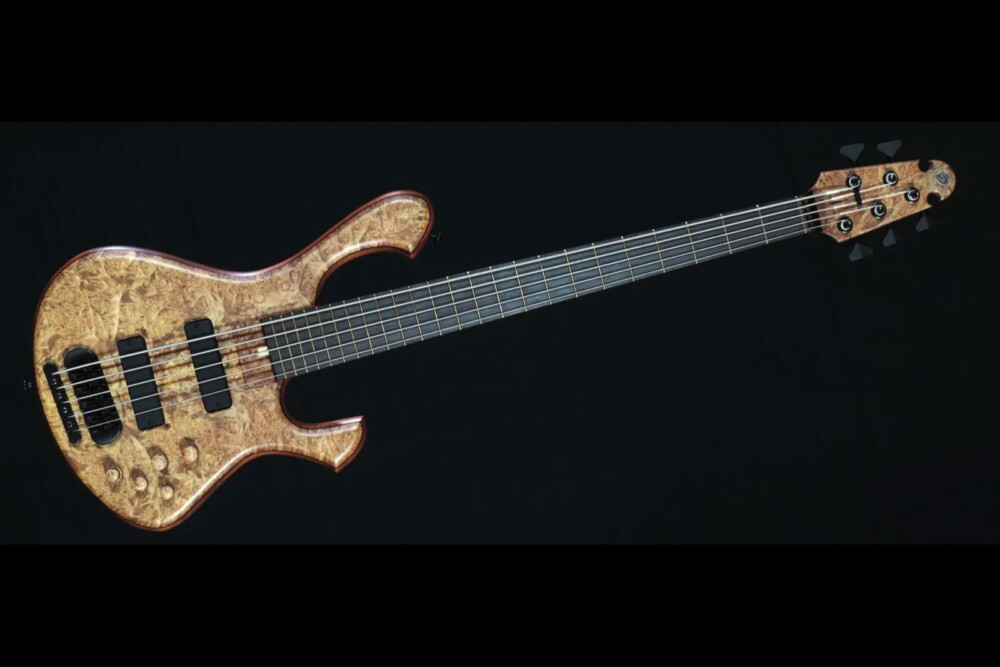
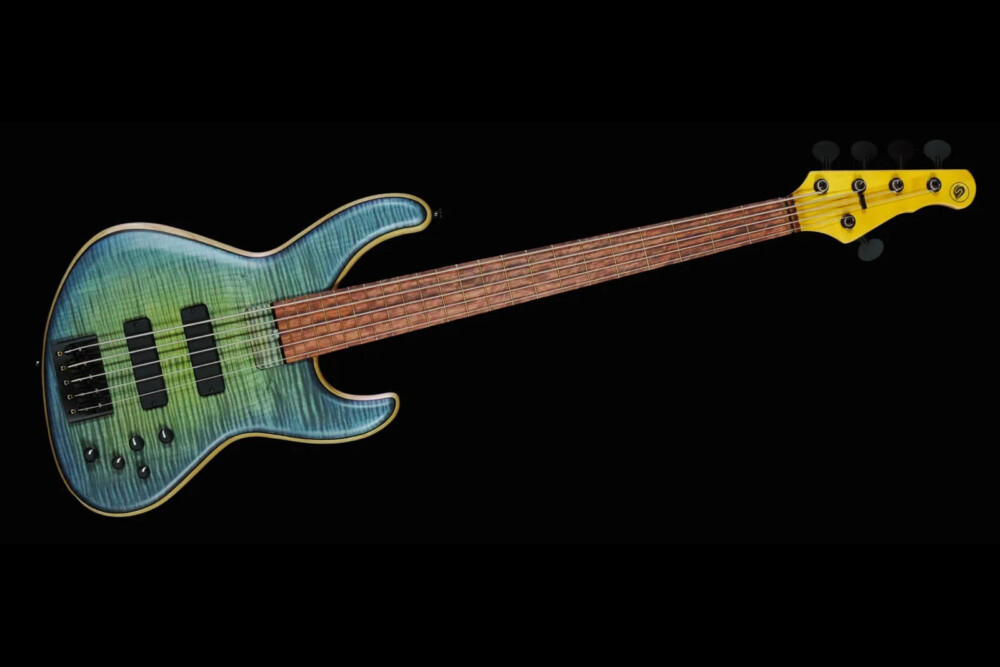
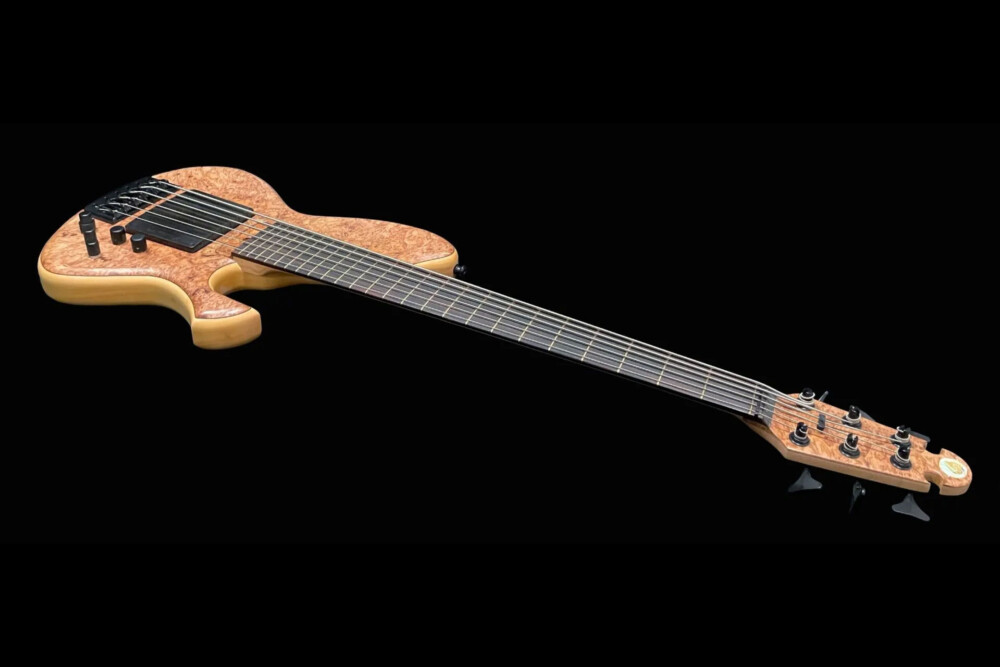
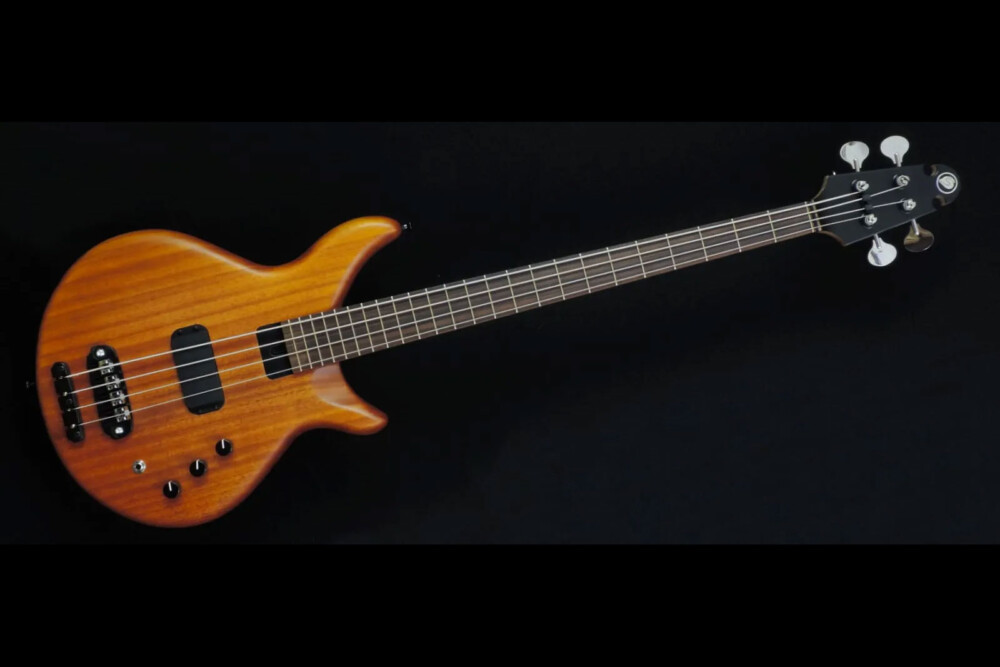
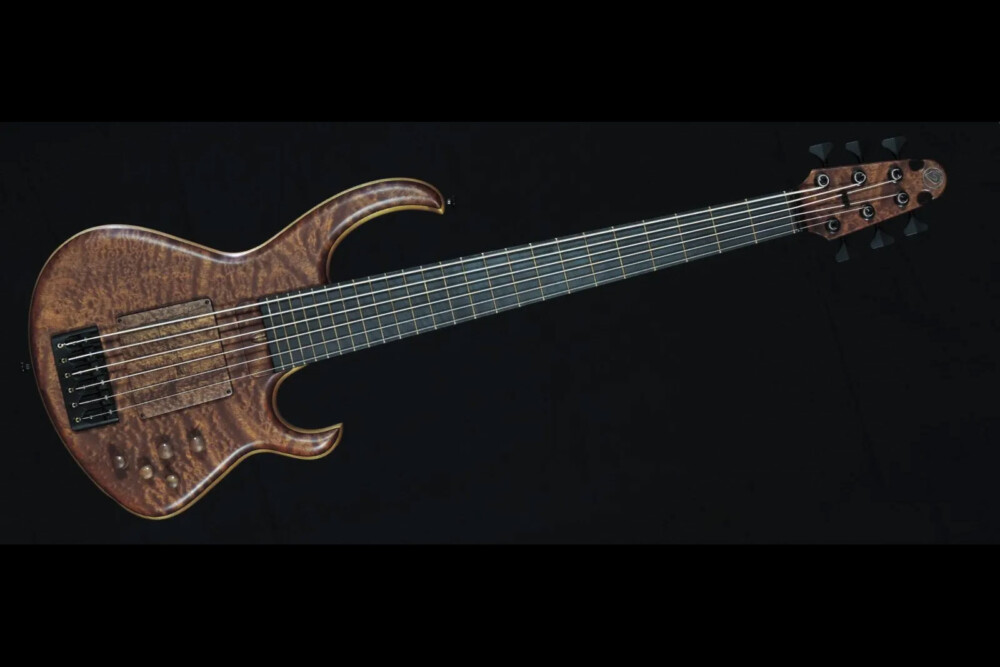
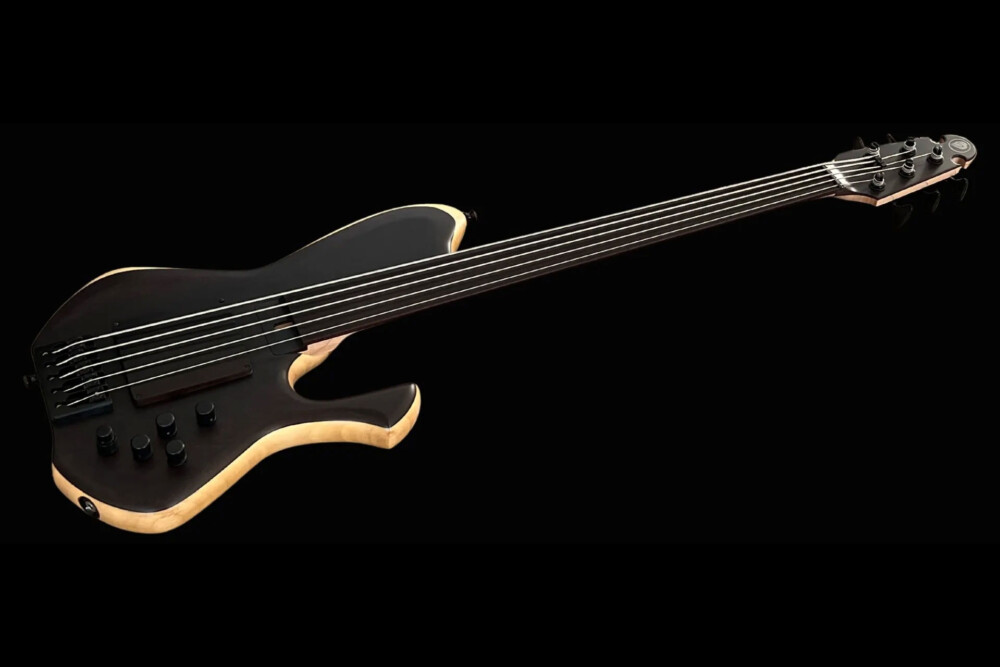
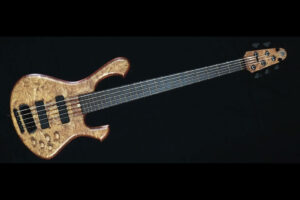
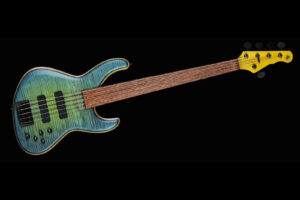
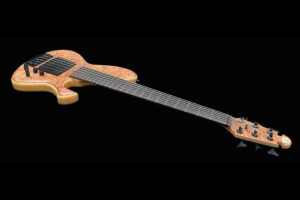
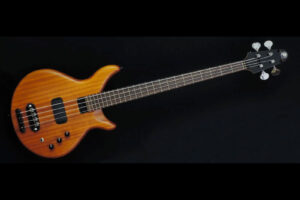
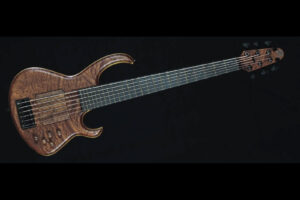
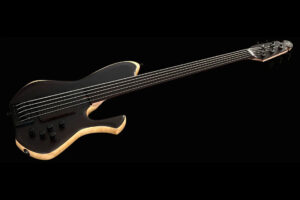
I was going to say, “This sounds familiar.”
Yeah, yeah, yeah. Well, people ask me how I got into building. I was a bass player first, and then I decided I’d find another industry that’s very difficult to make a living in. [laughs]
What really got me into it was the fact that I was playing, and I wanted to stay attached to the bass guitar and music. The best way I saw was I could control a product versus being an artist, which is so hard because you can do something you think is great and a lot of people think is great, but to turn that into a monetary thing… It’s art. It’s hard. It’s so subjective. Making a living off of it is super hard, no matter how good it is.
[Building a bass] was something tangible I could hold onto. Then other people could pick it up and say, “I like this, this is good for these reasons, and I can justify paying the money for something like this.” It was basically the way to keep me connected to music.
I’m still playing, and now I’m back out playing a lot, which has been great because that’s the other reason I got into all of this. So, to be able to do the two things together again is really satisfying.
I loved the clip you sent of yourself playing with Charlie Bonnet.
Yeah. That’s been a lot of fun because it’s essentially 90% original stuff we do on stage, all of his music. I get to play my bass lines to the songs, which freed me up to be creative again. When I go out there, I’m not just playing a cover tune or the same songs I’ve played forever. They’re living, breathing things that I get to interact with on stage with two other guys who are really into it, as well. So it’s fun again.
There again, as much money as I make, it’s justifying me doing it. There’s enough money to get to the next gig. But at this point in my life, it’s why I’m doing it: because it’s fun, and I’ve worked so hard to be a good bass player that I don’t want to let that just die on the vine. I’m glad I can actually have an outlet for it.
When you started Skjold Design Guitars 20 years ago, what was your thought process? What were some of your strategies as a new builder?
People were always asking, “Well, what’s your business plan?” I didn’t have any formal business training, so I had no idea what they were talking about. My business plan was “I’m going to make the best basses in the world that I can. If I make a really great instrument, all the rest of the stuff will follow.”
My only focus was the instrument and making it as good as I possibly could at that moment. I was also trying to refine everything that I could do because I didn’t come at this as a woodworker with a lot of experience behind me. I came at this as a player who was really focusing on just a bass guitar because that’s what I played, and that’s what I wanted to make.
I played all these really nice high-end instruments by Tobias, Pedulla, Modulus, and Roscoe, so I knew exactly what I was trying to go after. I also knew how I could possibly make a little tweak here and there for someone like me to appreciate it a little bit more. That wasn’t something that everyone was doing across the board. You would think it would be natural, but they weren’t all players.
Standing on stage for three or four hours a night, you realize, first of all, “I should have a lightweight bass.” Something that feels good when I’m playing it, something that is versatile tone-wise, so you can actually use one instrument as a sideman. You don’t get the luxury of bringing 30 basses and playing a different bass for every song. I mean, most bass players would love to do that, but most of the time, we’re stuck with a bass that’s gonna have to do a lot of stuff. I learned that playing in Las Vegas for nine years.
So, starting off, my whole thing was just getting the basses as consistent as possible by perfecting my methods of how I was doing it. I came up with a lot of my own ideas and my own ways of doing things because I didn’t have any formal training. I had to really think outside the box as far as how I would get the results I wanted.
And I think it’s a good thing I didn’t have all those other ideas in my head because I probably wouldn’t have gone in the direction I went. I had a couple of other apprentices who have come in at different times and have been very blown away by how I do things compared to how they learned formally in schools. Something I want to bring to the marketplace later on is some of the methods I use and some of the things I’ve developed for making basses.
You have to make them as efficiently as possible. Consistency is supremely important. There’s not a CNC carving any product. I’m doing everything by hand, so there’s a lot of jig-making that goes into it and a lot of refinements of processes so you can do it consistently and quickly. Because all the handwork later on is what takes all the time. All the little things – the fretwork, the leveling of the fingerboard, all that stuff – eat up your time so you want the easy things to be really well done and very efficient. That just moves everything forward.
I think it’s incredible you can get so consistent with just hand work. So that’s all done with jigs and the like?
Yeah. Well, that’s the one thing when you’re doing things with machines. A lot of people let the machine do most of the work. They get it to a point, but sometimes, they don’t go back and refine what the machine has done. The machine doesn’t understand anything outside the program. It’ll do the program perfectly, but I’ve just never seen an instrument made solely by a CNC that plays like the stuff I make because I don’t think they do those next little steps. Some guys do, and those instruments are really well made, too.
There’s no getting around what you have to do to get it to do what you want it to. You have to program the CNC really well, or you have to take the extra steps after it comes off the machine. Even though people think the machine is perfect, it’s not. You’ve still got a little ways to go.
I think that handmade attention goes into that. That’s where you get those instruments that play really well and have a soul to them. That’s the difference between something that’s a production instrument that comes off an assembly line from someone who probably doesn’t play the bass and probably doesn’t do anything outside of a few jobs on that assembly line. They don’t know that little tweaks can make it play better.
Being the only guy making the instrument, you get to see every little thing you’re doing and you get to criticize every part of the steps and find improvements. So, for 20 years, I’ve been refining my process and getting everything to where now I feel like I’m making the best bass I’ve ever made.
What are some of the biggest refinements you’ve made from your early basses to now?
To be honest, my basses sounded really, really good right out of the gate. That’s what I think. That’s the main thing that got me some street cred right there. I was giving these basses to some players in different areas, and they were taking them to the studio. I got feedback like, “These things sound amazing. Your B string sounds great.” That helped me there because I didn’t tweak anything that worked. I just reinforced why it worked.
I use a thick fingerboard. That definitely impacts the sound, so I’ve always kept that. Some of these things were kind of random, like accidents or learning curves. You realize, “Wait a second, that actually works really well. Let’s keep that.”
Over the years, it’s been little things like graphite in the neck, custom hardware, custom electronics, custom pickups, and then refinements on how I make the neck to the shape I want. I have a shaper bit that gives me the basic profile as Fender did back in the day. I did that because I didn’t want to have inconsistent necks every time I carved one, so I found a way to give me the profile I needed. Then, from there, I can tweak it, carve it, and make it thicker or thinner.
The biggest thing I would say, though, would be learning the geometry of the fretboard and the frets, because there’s actually geometry to that. It’s not just one level; there are actually several intersecting planes to get that thing to work properly underneath the strings. You’ve got a bridge, and the bridge doesn’t move. The nut does move up and down, which changes everything. Then you’ve got the fingerboard that’s gotta be in relationship to the strings, and that actually has to have a slight geometry built into it if you want it to play well without any buzzing.
I’ve been able to get my G string and C string down to like 1/64th at the 24th fret and still play without any issues, which is blowing my mind, too. It’s crazy, but the fact is, if the math is done right, you could get it to do that. I mean, you can’t just slam away, but you could play it, and it’s not buzzing anywhere because of the workmanship.
When that happens, I’m happy, and I feel successful. At the end of the day, if I can make myself happy by making an instrument that I would love to own or play, then I’m happy, and I know that it can go out to the world and people will enjoy it for a long time. That’s really what art is. You have it briefly, and you share it with the world. If they respond to it, you can keep doing it.
One of the things your basses are known for is your ramps. As you know, ramps have picked up over the last decade. How do you explain what ramps are for to people and what makes your ramps different?
The basic ramp is used for a technique where you rest your fingers on the ramp very close to the strings. I believe Gary Willis is the guy who used it as a technique-building process. It keeps you from digging in too far, and you can turn your instrument up and play lightly while also playing with a lot more economy because your fingers are actually stopping at a certain point on the ramp.
I tell certain players, “If you don’t use a ramp, don’t get it.” If you’re the kind of player like me who plays through the strings and plays a classic fingerstyle, that’s not what it’s made for. I’ve had to learn how to play with a ramp because it’s in my way, you know?
Damian Erskine helped me develop it, mainly because he wanted it, and I didn’t have one. I was putting flat or slightly rounded ramps that go in between the pickups. It was just a piece of wood.
The big issue was once you taped it to the body, there was no adjustability, and that’s what most people were doing. They were taping it, and then they would shim it get a little bit higher, or they would take it down a little bit by sanding it. It seemed haphazard to me in a way that it wasn’t universal across the board. You couldn’t put something on there, and everyone could play it properly.
So Damian came to me and said, “Listen, I need that ramp. I have to have it for a technique that I need.” And I said, “Okay, well, we’ll just put a piece of wood in there, like I’ve always done.” And he says, “Well, can we round over the pickup radius so they match the ramp?”
I thought that meant I was going to have to make a special casing of some type for the pickup, which would mean I’d have to go into that process. So then I thought, “Well, wait a second, if I’m going to make the whole pickup ramped, why don’t I just make the whole enclosure one thing?”
So the ramp and the pickup covering are all integral to one thing, and then it’s all adjustable like a regular pickup is. So now you can adjust it as you need it. Any player can get what they want for height out of it, which is the most critical part of it.
The one thing you really have to do when you make a ramp is you have to have a special pickup type to go into it. In other words, you can’t be in a plastic casing, and you’re just going to try to put a regular off-the-shelf pickup in the ramp. It’ll be way bigger. There’ll be a little bit too much distance from the strings to the plastic and the wood. So I’ve had my pickups made special to go right up against the wood at the very top. There’s very little gap or plastic in between them.
Are you seeing any other new trends in the bass world?
Recently, I’ve seen more of the multi-scale stuff. I’ve never seen a huge difference or advantage going in that direction for my instruments, so I’ve never really adopted it. But that’s been one big thing I’ve seen because the patent ran out that Novak had, and once the patent ran out, everyone jumped on it.
Headless is coming back in a big way. That’s been cool. For a long time, I had some things developed with Hipshot and just couldn’t get the time to prototype one out.
Over the pandemic, I took the time off to work on little things I wanted to do in the near future. So headless is back on my table, too. I’m doing many things with headless now that I’m really excited about. And there’s some new hardware out there, too, that’s really, really cool. So I’m exploring that a lot.
Oh, the really short scales are the brand new thing that everyone’s pushing. People are wanting them, so I’m actually going in that direction again just to see where my stuff falls in that category, as well.
Are you trying that on your existing model, or are you trying to create a new model for that?
Actually, it’s kind of going back to the beginning because I have a whole bunch of 92 bodies that I did a long time ago that I just cut out, and I never kept them going. I had them cut out, and as I was working through my inventory, I figured, “There’s so many of these. These would make a great headless short-scale base, like a 30-inch scale or 32.”
It’s a compact instrument that someone can travel with a lot easier. The body is compact to begin with because I’m going back to the 92, which is the original body shape, which I wanted to be very, very compact. It’s almost like it’s a travel bass. It’s been 30 years in the making. So I will revisit that first and then see what I can come up with on that instrument.
I can make that a limited edition and then blend that into what else I offer. Making the templates and making all the tooling and everything that you have to do, all the processes… that’s a huge amount of time. I rarely get that much time in a block where I can do that all and make sure it works and not make a prototype that is going to a customer because that’s always nerve-racking.
I think a lot of players will be excited about that.
Yeah. I have my own strings, and I’ve learned about string construction versus scale length. A lot of things are contrary to what we grew up thinking in the ’80s and ’90s with bigger gauge strings. When the five-string came out, it was all about getting that B string to sound good. A lot of people thought to get a bigger gauge string for more tension, but the reality is it feels floppier, even though there’s more tension on a bigger string.
Going shorter scale, a smaller gauge will give you a tauter feel. And that’s why like, on a 35-inch scale high C, if you have a six-string, it always feels really, really hard to play because it’s so tight.
Another thing I’m experimenting with is string tensions and string gauges and things like that. I’ve had a few guys that are now getting strings for high C that are .40 gauge strings, which is like, “Wait, what?” But it makes a really fat-sounding and soft-feeling C-string because it’s actually a little tighter, but because it’s bigger, it feels less taught.
With 20 years of full-time building under your belt, what kind of advice do you have for someone wanting to get into bass building, either as a hobbyist or a business?
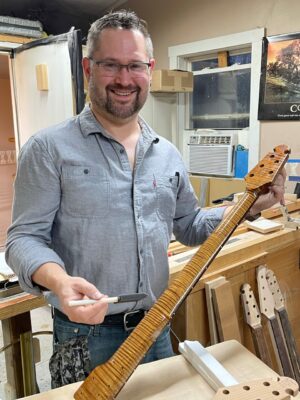 The hobbyist has it probably better than we’ve ever had it, because there are so many things available to them now. Back when I started, if you wanted to get wood, you had to know the guys who were selling the wood to the big companies. There weren’t a lot of wholesalers or retailers. You weren’t going to go into a store and find wood you could actually make an instrument with. You weren’t going to go online and find all these guys selling instrument-grade wood.
The hobbyist has it probably better than we’ve ever had it, because there are so many things available to them now. Back when I started, if you wanted to get wood, you had to know the guys who were selling the wood to the big companies. There weren’t a lot of wholesalers or retailers. You weren’t going to go into a store and find wood you could actually make an instrument with. You weren’t going to go online and find all these guys selling instrument-grade wood.
You had to know somebody, and usually, that was another luthier you had to convince to sell you some stuff. I remember buying my first wood from Greg Curbow. A lot of my wood came from him, and he was very generous with his knowledge, as well. But you know, I don’t know where he got it. I had to find that stuff out for myself. I had to go to wood places and slowly go through that whole process.
Now you don’t have to worry about that. You can get literally anything you want to make a bass from out there, plus you have a lot more companies building parts. As you probably remember, Warmoth was the only company in the game for a long time. Now, there’s a whole industry built around buying parts to build your own stuff. So the hobbyist has it probably better than they’ve ever had it.
On the flip side, if you want to do this for a living, it’s probably the most challenging it’s ever been because now you have everything at retail. Everything you used to get wholesale is now retail. The wood is super expensive now. I’m still having a really hard time buying stuff because I remember what I paid for it 20 and 30 years ago. Sourcing stuff is a problem.
You’re also competing with so many more builders now than ever because everyone can get into it in a much easier way, and everyone tries to make a go at it. The reality is that nothing changes as far as making a living at it, though. It’s still a lot of work. You’ve got to do all the necessary work to make the instrument what it is at the end. It’s just like playing music. You can’t look at a prestigious gig and say, “I want that gig,” and never rehearse the music. You’ll never get the gig. You have not done the work.
You have to learn to deliver the bass that people want at that level to make any money at it. You also have to charge what you need to charge. A lot of luthiers still have day jobs. They may be pretty popular luthiers, but they’re actually working a day job to support basically a paid hobby. When you get in this like I’m in it where you’re paying your bills with it, it’s really, really tough. And the amount of money that has to go into these things, if you’re making with expensive woods… Well, I’ll leave the pricing off the table, but you have to work at what you’re doing to get the money you need to get in order to keep going for 20 years. If you want to make a career out of it, you’ve got to invest. I’ve probably spent more money on wood than I’ve ever made taking home. It’s all in my wood that I’ve been buying that allows me now to go out and build stuff that I don’t have to go buy wood for. I have good stock; that’s a big deal. But now someone starting now is gonna have to go through that whole process at that super high premium price. It’s gonna be difficult.
What do you see for the future of Skjold Design?
There are some new designs coming. That’s something I seem to do every so many years. That’s part of the growing process, and that’s part of the refinement. I’m still following my muse. I’m still really into building. I still really love the process. I want to do it as long as I possibly physically can. That’s really my main goal right now is just to be healthy enough to continue to do it.
That sounds crazy, but that’s the way I’m thinking. If I could do another twenty years, I think I would be elated. I’m 53 now, so to be able to go that much longer into my career physically, I think that would be amazing. My goal is to be building to the point where I just drop dead right there. It’d be the last neck I carved and then just fall over. I think that would be the ultimate way to go for me.
Builders like Carl Thompson are really, really inspirational to me because he’s kept up that whole mantra, as well. All my heroes are in that stage of their life. Some have retired completely, like Mike Pedulla, and there are a few other guys who are right there on the verge of retiring. It’s going to be very interesting in the next ten years. I’m excited about that because there are not as many guys doing it the way I do it and the way the guys before me were doing it. It’s gone into another method of building. I think I’m left in the middle, and I like to be in that kind of position where if you want a handmade bass by an artist and luthier of my generation [then I’m here]. You know, there’s not that many guys that I can look around and see that are doing it. So it’ll be interesting to see what happens, you know.
I’m just really excited about the future.

